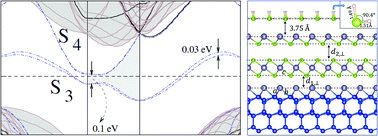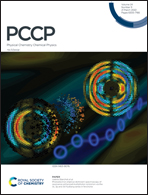Abstract
We have carried out an investigation using density functional theory (DFT) of the atomic and electronic structures of SnSe2 layers on the  surface and hydrogenation of this surface. We have considered a (2 × 2) SnSe2 superstructure oriented along the diagonal direction of the
surface and hydrogenation of this surface. We have considered a (2 × 2) SnSe2 superstructure oriented along the diagonal direction of the  surface periodicity, for which scanning tunneling microscopy (STM) measurements have recently been reported. In the band structure calculations, while the s–p character surface state originating from each SnSe2 layer is determined, there is an additional half-filled surface state in the fundamental band gap region due to the Sn adatom. At the
surface periodicity, for which scanning tunneling microscopy (STM) measurements have recently been reported. In the band structure calculations, while the s–p character surface state originating from each SnSe2 layer is determined, there is an additional half-filled surface state in the fundamental band gap region due to the Sn adatom. At the ![[M with combining macron]](https://www.rsc.org/images/entities/i_char_004d_0304.gif) point in the Brillouin zone, a charge density wave (CDW) partial gap opening of ∼0.1 eV occurs between these surface states close to the Fermi level. Here, the CDW gap is caused by two reasons; (i) Fermi surface nesting, due to the inequivalent electron pockets at the
point in the Brillouin zone, a charge density wave (CDW) partial gap opening of ∼0.1 eV occurs between these surface states close to the Fermi level. Here, the CDW gap is caused by two reasons; (i) Fermi surface nesting, due to the inequivalent electron pockets at the ![[M with combining macron]](https://www.rsc.org/images/entities/i_char_004d_0304.gif) point, and (ii) the out of plane weak electron–phonon coupling regime due to the mean-field (MF) theory (2Δ/kBTMF = 3.52). Upon hydrogen adsorption on the
point, and (ii) the out of plane weak electron–phonon coupling regime due to the mean-field (MF) theory (2Δ/kBTMF = 3.52). Upon hydrogen adsorption on the  surface, we have obtained a β-phase SnSe layer and SeH2 molecule with a bond angle of ∼90°. The hydrogenated surface pushes the surface state associated with the SnSe2 layer into the Si projected bulk band continuum. After SeH2 desorption, the work function drops from 5.20 eV to 4.39 eV.
surface, we have obtained a β-phase SnSe layer and SeH2 molecule with a bond angle of ∼90°. The hydrogenated surface pushes the surface state associated with the SnSe2 layer into the Si projected bulk band continuum. After SeH2 desorption, the work function drops from 5.20 eV to 4.39 eV.




 Please wait while we load your content...
Please wait while we load your content...
 and the effect of surface hydrogenation
and the effect of surface hydrogenation